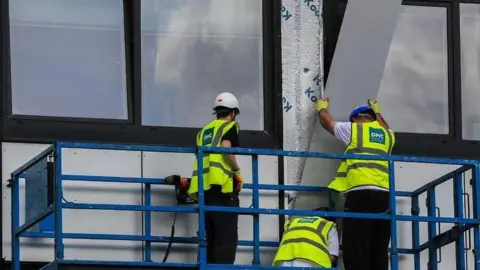**Costs of Cladding Remediation Impact Taylor Wimpey’s Profits**
Taylor Wimpey, one of the UK’s largest housebuilders, has announced that unanticipated expenses related to the removal of cladding have eliminated its profits for the first half of the financial year. This follows the tragic Grenfell Tower fire, which ignited concerns about fire safety across many buildings, leading to increased scrutiny and regulatory pressure on construction firms.
The company disclosed a significant loss, attributing this downturn to an additional £222 million reserved for addressing fire safety defects in homes it developed. This substantial financial adjustment comes as the firm’s share prices took a hit on Wednesday after the announcement, coinciding with a noticeable slowdown in sales. First-time buyers are particularly feeling the pinch, struggling to enter the housing market amid rising interest rates and increasing living costs.
The Labour government has put a strong emphasis on boosting housebuilding, hoping to rectify the housing crisis. However, analysts are cautioning that private companies may be deterred from constructing new homes due to the prevailing high-interest rates that limit affordability for many potential buyers.
Jennie Daly, the Chief Executive of Taylor Wimpey, commented on the situation, indicating that financial conditions remain challenging, especially for first-time buyers. Although banks and building societies are still willing to lend, the demand is not sufficient to offset the rising costs and heightened economic pressures.
In July, Taylor Wimpey reported a decline in its sales rate compared to the same month the previous year, revealing that the average price of UK homes sold by the company has decreased to £313,000 from £317,000. This falling sales price is reflective of the underlying challenges in the housing market, including the increasing difficulty for first-time buyers to secure mortgages as interest rates have been on the rise since 2022.
Recent trends indicate that these first-time buyers are now facing extended borrowing terms; the average mortgage term has ballooned to 31 years as individuals strive to minimize their monthly repayments. Alongside this, Taylor Wimpey recorded a pre-tax loss of £92 million over the first six months of the year. This loss is primarily attributed to “exceptional charges” related to the costly cladding remediation efforts.
The urgency for such remediation arose after the Grenfell fire incident in June 2017, which claimed the lives of 72 people due to the inadequate safety standards that allowed a fast-spreading blaze fueled by combustible materials used as cladding on the residential building’s exterior. An inquiry concluded that every death was preventable, leading to widespread accountability measures for construction firms.
Although Taylor Wimpey was not responsible for installing the cladding on Grenfell, the company has reported that unforeseen defects discovered during the remediation of their own buildings have contributed to soaring costs. Coupled with inflated construction expenses and new assessments mandated by fire safety engineers, these factors have significantly impacted Taylor Wimpey’s financial standing.
In total, Taylor Wimpey has allocated £435 million for ongoing cladding remediation, incorporating the recent £222 million increase in its reserves. This financial commitment underscores the broader challenges faced in the housing sector concerning safety, affordability, and regulatory requirements, which will likely continue to exert pressure on builders and the overall housing market for the foreseeable future.
As the situation unfolds, the housing industry will have to find mechanisms to adapt to the demands for more stringent safety measures while also addressing the needs of a market that historically struggles with access, especially for first-time buyers. The unfolding economic landscape will be crucial to watch as companies like Taylor Wimpey navigate these complexities in their effort to restore profitability while ensuring safety in their housing developments.












